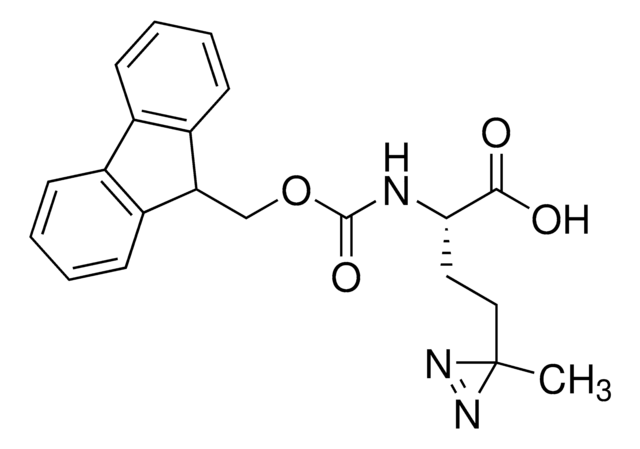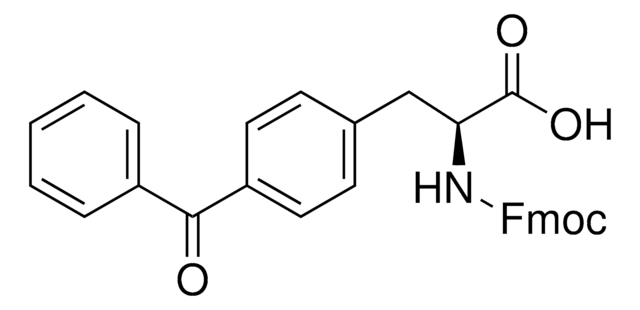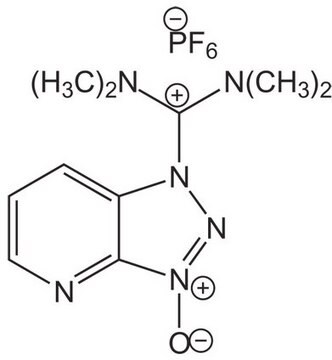おすすめの製品
アッセイ
≥98%
形状
powder
反応適合性
reaction type: Fmoc solid-phase peptide synthesis
アプリケーション
peptide synthesis
官能基
Fmoc
保管温度
2-8°C
アプリケーション
Fmoc-L-Photo-Leucine is a diazirine-containing, Fmoc-protected leucine amino acid and multifunctional photo-crosslinker. Its incorporation into peptides or small-molecule probes and tools allows for photoaffinity labeling of cellular targets and protein-protein interactions upon UV light (∼360 nm) irradiation to form a covalent bond. This and other multifunctional probe building blocks will continue to accelerate drug discovery research for probing cellular mechanisms, target ID/validation, and understanding traditionally undruggable targets. An unprotected version is also available as 907278.
Product can be used with our line of photoreactors: Including Penn PhD (Z744035) & SynLED 2.0 (Z744080)
Product can be used with our line of photoreactors: Including Penn PhD (Z744035) & SynLED 2.0 (Z744080)
その他情報
Synthesis of a polymyxin derivative for photolabeling studies in the gram-negative bacterium Escherichia coli
Developing diazirine-based chemical probes to identify histone modification ′readers′ and ′erasers′
Protein-Polymer Conjugation via Ligand Affinity and Photoactivation of Glutathione S-Transferase
Fishing for Drug Targets: A Focus on Diazirine Photoaffinity Probe Synthesis
Photo-affinity labeling (PAL) in chemical proteomics: a handy tool to investigate protein-protein interactions (PPIs)
Developing diazirine-based chemical probes to identify histone modification ′readers′ and ′erasers′
Protein-Polymer Conjugation via Ligand Affinity and Photoactivation of Glutathione S-Transferase
Fishing for Drug Targets: A Focus on Diazirine Photoaffinity Probe Synthesis
Photo-affinity labeling (PAL) in chemical proteomics: a handy tool to investigate protein-protein interactions (PPIs)
関連製品
製品番号
詳細
価格
保管分類コード
11 - Combustible Solids
WGK
WGK 3
引火点(°F)
Not applicable
引火点(℃)
Not applicable
適用法令
試験研究用途を考慮した関連法令を主に挙げております。化学物質以外については、一部の情報のみ提供しています。 製品を安全かつ合法的に使用することは、使用者の義務です。最新情報により修正される場合があります。WEBの反映には時間を要することがあるため、適宜SDSをご参照ください。
Jan Code
907391-VAR:
907391-50MG:
907391-BULK:
最新バージョンのいずれかを選択してください:
Benjamin van der Meijden et al.
Journal of peptide science : an official publication of the European Peptide Society, 21(3), 231-235 (2015-02-03)
The antimicrobial activity of polymyxins against Gram-negative bacteria has been known for several decades, but the mechanism of action leading to cell death has not been fully explored. A key step after binding of the antibiotic to lipopolysaccharide (LPS) exposed
Aleš Marek et al.
Journal of the American Society for Mass Spectrometry, 25(5), 778-789 (2014-02-20)
Gas-phase dissociations were investigated for several peptide ions containing the Gly-Leu* N-terminal motif where Leu* was a modified norleucine residue containing the photolabile diazirine ring. Collisional activation of gas-phase peptide cations resulted in facile N₂ elimination that competed with backbone
Jay M Janz et al.
Journal of the American Chemical Society, 133(40), 15878-15881 (2011-09-13)
Cell surface heptahelical G protein-coupled receptors (GPCRs) mediate critical cellular signaling pathways and are important pharmaceutical drug targets. (1) In addition to traditional small-molecule approaches, lipopeptide-based GPCR-derived pepducins have emerged as a new class of pharmaceutical agents. (2, 3)
Developing diazirine-based chemical probes to identify histone modification 'readers' and 'erasers'.
Tangpo Yang et al.
Chemical science, 6(2), 1011-1017 (2015-02-01)
Post translational modifications (PTMs, e.g., phosphorylation, acetylation and methylation) of histone play important roles in regulating many fundamental cellular processes such as gene transcription, DNA replication and damage repair. While 'writer' and 'eraser' enzymes modify histones by catalyzing the addition
En-Wei Lin et al.
Bioconjugate chemistry, 25(10), 1902-1909 (2014-10-16)
A photoactivated, site-selective conjugation of poly(ethylene glycol) (PEG) to the glutathione (GSH) binding pocket of glutathione S-transferase (GST) is described. To achieve this, a GSH analogue (GSH-BP) was designed and chemically synthesized with three functionalities: (1) the binding affinity of
ライフサイエンス、有機合成、材料科学、クロマトグラフィー、分析など、あらゆる分野の研究に経験のあるメンバーがおります。.
製品に関するお問い合わせはこちら(テクニカルサービス)








